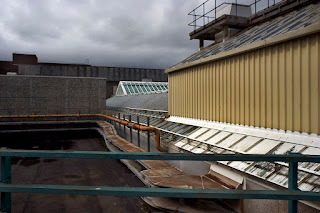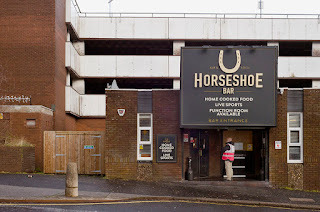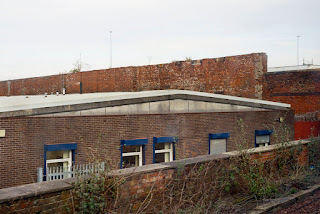Recent Photographic Work
After completing my zine, Greenock/Gourock, mentioned in a previous post, I continued working on two other photo zines also relating to Greenock: Fifty and Greenock Central to Glasgow Central. I then decided to combine all three into a book, with the images from each zine as a separate section or chapter. The book is called Gourock, Greenock, Glasgow. Below are the intro texts for each zine (these have been slightly edited for the book version but not changed substantively), plus two images from each zine/book section.
Intro text for Greenock/Gourock:
I live in Gourock; I go shopping in Greenock. I walk around Gourock; I travel to Greenock by bus. Thiszine is about the differences and similarities between the two places.Gourock (current population 10,000) was originally a fishing village, then a seaside resort, and is nowa suburban residential area. It has a few shops, but no real economy. Rather, people travel from there towork, mainly by car. Some no doubt have jobs in Greenock, but others commute to Glasgow, which isabout an hour away on the motorway. I rent a room here, but the area where I live is mostly a zone ofowneroccupation,with detached or semidetachedhouses set back from the street by gardens. However,Gourock also has several areas of public housing, which are more densely inhabited and have more genericarchitecture.
Greenock (current population 41,000) is a larger regional centre, with local government buildings forInverclyde Council, a shopping mall, chain supermarkets, etc. But it is itself a satellite of Glasgow, and itsnineteenthcenturyprosperity depended on that proximity: that is, it is closer to the mouth of the ClydeEstuary than Glasgow, so it was easier and cheaper for some ships to unload sugar, tobacco and cottonthere rather than continue on to the larger city. The town was also a centre for shipbuilding and relatedindustries. Like many Atlantic ports and old industrial centres, Greenock’s fortunes have fallen, but itretains a busy freightcontainerterminal – and during the summer cruise ships use the town as a base forday trips. Greenock has greater visible extremes of wealth disparity than Gourock, with larger councilestates, including tower blocks, but also very grand individual houses, most of which seem to date back tothe town's heyday.
Suburbia is a place where dogs bark at solitary walkers. Being without a car and being alone are bothinherently suspicious states of being – taking photographs is even worse. If I could completely effacemyself, I would. I live a marginal existence, and I wanted these photos to express that: to depict not aninvasion of privacy, but a reluctance to trespass. A sense of distance and withdrawal – of tactfulness.
Intro text for Fifty:
I recently moved into a Housing Association flat in Greenock, a small post-industrialtown near Glasgow.When I counted up, I realised that this is the fiftieth place I’ve ever lived, which – since I’m in my mid-fifties– averages out at just over a year per location. The longest I’ve ever stayed in one place was in thehouse where I was born, for the first eight years of my life, followed by my aunt’s house in Liverpool,where I lived during my time in secondary school from 1981–8, and again for several months in 1998. The longest I’ve stayed anywhere as an adult was a rented flat in Sydney from 2006–11. I’m still surprisedto have ended up in Greenock, but I’m glad to have an apartment to myself after several years rentingrooms in shared accommodation. Because it’s a Housing Association flat, I can stay here as long as I want.So I’m trying to get to know my town: to relearn what it might mean to inhabit a place.Intro text for Greenock Central to Glasgow Central:
Train windows were the original screen technology. Long before the invention of cinema, they offered anendlessly scrolling spectacle to a seated passenger, who could not touch, enter or otherwise affect theworld beyond the glass. The photographs in this zine were taken on train journeys between GreenockCentral and Glasgow Central stations during February 2025. It might seem odd to think of these imagesin terms of spectacle, since that word normally implies something impressive or dramatic, and mostlywhat they show is the reverse of things. Back gardens, industrial estates, brownfield sites – along with theinfrastructure of the railway itself: bridges, power lines, and so on. But in many respects photographingfrom a train window is like photographing a cinema screen. On previous projects, I moved around apossible subject on foot, looking at it from different vantage points, and I often returned to the same sitemultiple times. Here, I couldn’t change my position, except insofar as the train itself carried me along. Atmost I could choose which side of the train I sat on, or which direction I faced. Or I could adjust myangle of view, for example with a zoom lens.
There were other constraints. I sometimes had less than a second to frame and photograph a subjectmoving past me at up to 90mph, and if I missed it, the only way to have another go was to retake thesame journey. In addition, the window glass, usually rather dirty, worked like a giant Vaseline filter, and,even worse, often held intrusive reflections from the train interior. When moving at fast speeds, there werealso far narrower tolerance limits for focus and shutter speed than normal. I’ve tried to minimise all theseeffects, but haven’t been able to eliminate them entirely. Under these circumstances, it was necessary toredefine what a ‘good’ photograph was: it became one that invoked the experience as much as one thatdescribed the subject. To put it another way, the constraints became part of the subject.
Two images from each zine/section:






None of this work is currently available for purchase. I've just printed sample copies for myself and friends. Maybe someone else will publish it in future, or maybe not – more likely the latter, given the economics of photography publishing. I may take some of the sample copies to a local zine fair or two. But it was worth doing I think, irrespective of the outcome. Anyway, that's enough photography for the foreseeable future. Back to writing!
Published on March 26, 2025 08:38
No comments have been added yet.



